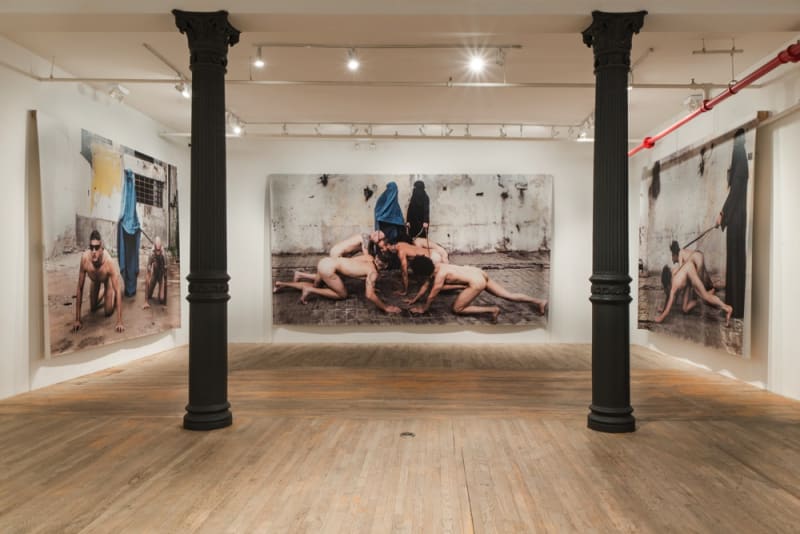Kozyra is, first and foremost, a creator of striking, complex, photographs, videos and performances where the symbols of subjugation and oppression have been intentionally complicated and jarringly re-presented in ways that make us question our assumptions of what is right, what we know, what we expect, and what we put up with.
She infiltrates, observes and documents the worlds to which she does not naturally belong - like in her Venice Biennale winning installation "Men's Bathhouse" (1998), where disguised as an androgynous boy, she entered men's baths and secretly filmed the scenes inside. Or like in "Punishment and Crime (2002) , where she befriended Polish weapons enthusiasts and filmed their violent proceedings. Or like in "Looking for Jesus" (2012-2018), where she found and interviewed men who consider themselves the Messiah, in and around Jerusalem.
In chronological order the works on view are: Pyramid of Animals (1993) was inspired by the Brothers Grimm fairytale Town Musicians of Bremen, and consisted of taxidermied animals: horse, dog, cat and rooster, accompanied by film footage of the horse's slaughter. At the time of its making, the piece stirred up an unprecedented scandal in the media, which turned it into the most famous Polish artwork of the last quarter-century. It is in the collection of Zacheta National Gallery of Art. Here Pyramid of Animals is represented by a newly published vintage photograph.
Lou Salomé (2005) is a video and a photographic series which likens humans to animals - and animals to humans. In Lou Salomé, Kozyra portrays the titular Russian-born intellectual and femme fatale who was a friend of Friedrich Nietzsche, Sigmund Freud and Rainer Maria Rilke. Salomé leads Nietzsche and Rilke, chained and leashed like dogs, through the halls and gardens of the Schwarzenberg Palace in Vienna. Realized in 2005, Lou Salomé is being exhibited publicly in its entirety for the first time.
The video A Dream of Linnaeus' Daughter (2018) was shot in Uppsala, Sweden, in the gardens of Carl Linnaeus, the famous 18th century botanist and taxonomist. Kozyra, in the role of Linnaeus' botanist daughter Elisabeth Christina von Linné, conducts an animal choir singing Beethoven's iconic Ode to Joy. As they stand on wooden pallets symbolizing Noah's Ark, the moos and squeals of her dog, donkey, cow, horse, goat and monkey choir fill the garden with what now is the anthem of European Union.
Central to the exhibition is the series Homo Quadrupeds (2018), presented as monumental ten foot-tall prints of naked men harnessed and led on leashes by burka-clad women. Testing the limits of cultural appropriation, Katarzyna Kozyra adopts the Burka as a symbol of female oppression, an instrument of restriction, one that literally renders a woman invisible. But it is men as dogs, in their full body splendor, tattooed and muscular, that are shown subdued and subordinate. The fields are not just leveled, but inverted; and the women's place on the male-dominated planet, especially in the context of #metoo, is subverted. In the photos the dogs sniff each other ready to fight. It is no longer only a matter of liberating women from male domination, as in, for example, VALIE EXPORT and Peter Weibel's 1968 performance Aus der Mappe der Hündigkeit (from the Portfolio of Doggishness), in which Weibel heels obediently at the artist's side. Here even though the men are dominated, they also remain beholden to their violent, competitive, rivalrous instincts, straining against their bonds, not to be free, but only to fight against each other.
Solo exhibition
26 Apr – 31 May 2019

